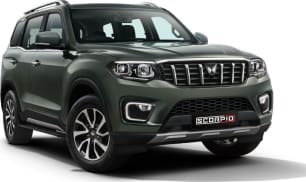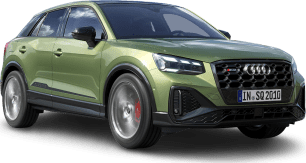The Scorpio is a 4WD with a body-on-frame chassis. For those of you who don’t know (no shame in that) a body-on-frame chassis denotes a chassis onto which the vehicle’s separate body is attached, and the engine, wheels, and suspension are fitted.
The set-up is well suited to towing and/or carrying heavy loads, and 4WDing.
It’s 4662mm long (with a 2750mm wheelbase), 1917mm wide and 1857mm high. It has a listed kerb weight of 2100kg and a 12.6m turning circle.
Right, that’s enough (boring?) measurements for now.
This Mahindra 4WD is surprisingly refined on-road: quiet inside, comfortable and with a no-stress engine and a low-key workmanlike Aisin-sourced auto delivering a relaxed, almost lethargic combination on the road.
Steering has a nice weight to it, ride quality is okay, erring on the side of spongy rather than too firm, and some body roll creeps in on more energetic bends.
Overall, however, the Scorpio does satisfactorily well on sealed surfaces. But how does it perform off-road?
The Scorpio handled the undulating dirt track leading to our off-road test site with ease, riding nicely over the light to medium corrugations, and was only ever minimally unsettled by the bumpy terrain.
This Mahindra is able to be shifted between 2WD and high-range 4WD (4H on the dial) so you can keep moving even when the road/track surface changes all of sudden.
The Scorpio has plenty of old-school foundational 4WD mechanicals onboard – low-range and a rear diff-lock (albeit an automatic one) – and it also benefits from off-roading-oriented tech such as its 4Explor system with selectable terrain modes, each of which adjusts engine output, transmission settings and traction control to best suit the terrain, conditions and driving style.
It also has hill descent control and hill hold control.
Even its forward-facing camera comes in handy. I still think of these as more a novelty – I prefer to get out and check the track ahead or get a spotter to do the work for me – but I can see the inherent value of this tech in helping the driver to maintain vision, especially if forward visibility is compromised, say for instance up and over the crest of a steep rocky hill, or edging towards a steep drop into a creek bed.
While the Scorpio’s 400Nm may seem a bit lowly, that torque is on tap across a good spread of revs, and this 4WD does well with what it has. The engine keeps everything moving along nicely.
In terms of off-road-relevant measures, the Scorpio has 227mm of ground clearance, a guesstimated wading depth of 500mm or so (it’s not listed), and approach, departure and ramp-over angles of 27.2 (good), 21.3 (not so good), and 23.5 (okay) degrees, respectively.
The Scorpio is quite an effective off-road wagon and it tackled every obstacle it faced without fail, but it has to be driven with extreme care and laser-focused concentration.
No harm in that, I hear you cry. In response, I say, sure, but it’s bloody exhausting work having to nurse a vehicle through even innocuous terrain in order to avoid nudges, bumps and scrapes to its underbody and side steps.
Not to mention how tiring it is having to anticipate if/when off-road traction control and/or the auto diff-lock will engage – or not – at crucial moments.
Not a major concern on flat ground, but think about the auto rear diff-lock cutting out on you while driving up a rocky 32-degree hill. Yep, I’m old.
Now for some more of the Scorpio’s less-than-ideal characteristics.
1. I hinted at this in the previous paragraph: off-road traction control doesn’t seem as well calibrated as it should be. It’s a bit patchy in its application, and certainly not as seamless as the tech in something like the GWM Tank 300 (yes, I know – the Tank costs about $15,000 more.)
2. The automatic rear diff lock is on the wrong side of clunky, abruptly engaging as it senses wheel-spin then disengaging just as abruptly when it deems the problem over ... even if it isn’t quite over yet.
3. The Scorpio feels low: a lot of underbody components are vulnerable to rocks, tree stumps, track debris, and the AdBlue tank sits low behind the rear left-hand wheel.
4. The side-steps seem very flimsy. The right-hand side-step took a soft knock going over an exposed tree root early on one test day, which I thought nothing of. But when I looked at it soon afterwards, the fasteners had popped out at the front and middle of the sidestep.
I didn't think the bump had been anywhere near enough to result in that.
5. The Scorpio’s standard tyres – MRF Wanderer SUV tyres (255/60R18 “All-Season”) – are not great for hard 4WDing.
They don’t offer anywhere near the degree of grip you need in difficult 4WDing and they quickly became gummed up with mud. The Scorpio does have an underslung full-size steel wheel spare.
The Mahindra Scorpio Z8L has a listed payload of 510kg, and can legally tow 750kg (unbraked), and 2500kg (braked). Gross vehicle mass (GVM) is a listed 2610kg; gross combined mass (GCM) is 5155kg.
I experienced a bit of an issue on a drive home after a few hours of tough 4WDing: 4H kept trying to engage during a 100km stretch of highway.
A dot kept flashing above 4H near the shifter, and terrain modes (other than Normal) kept flashing on the centre console and driver info display and I was being prompted to drop below 80km/h to shift into 4H.
Of course, I’d earlier switched from 4H to 2WD at the end of our filming day (at the 4WD location) and made sure I'd engaged Normal mode before I left the dirt and drove onto a sealed surface.
When the 4H-related issues kept happening on the highway I was able to fix the problem by stopping, switching the Scorpio off and back on again – but I had to do this every 5.0km or so four times before it finally sorted itself out.
To Mahindra’s credit, technical staff members are looking into the issue.





















.png)





.png)


.png)

.png)

.png)



.png)

.png)
.png)

.png)


.png)




.png)










































.png)











.png)


















 copy.png)







.png)











.png)

.png)













.png)


.png)








